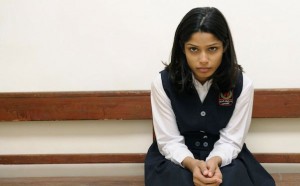Miral fails to create intriguing narrative
Miral, the new Palestine-set film from painter-turned-director Julian Schanbel, has arrived in theaters amid a symphony of howls and hisses from the American Jewish Committee and the Israeli government. 
In other words, a PR director’s wet dream. For Schanbel’s sake, I hope the fury doesn’t die quickly, because for all the fussing and fretting, Miral is a holy mess.
The film’s titular heroine (Slumdog Millionaire’s Freida Pinto) is a teenage Palestinian girl coming of age in a Jerusalem boarding school for orphans during the First Intifada of 1987.
The event, and a meeting with a handsome militant (Omar Metwally), pull the passionate Miral toward the teeth of violent resistance against the Israeli military, much to the dismay of her protective father (Alexander Siddig) and the school’s matronly head, Mama Hind (Hiam Abbass).
The film is greatly affected by the fact that, like directors Peter Bogdanovich and Roger Vadim before him, Schanbel took the artistically treacherous step of marrying a coworker: the film’s writer, Rula Jebreal.
An Italian TV journalist, Jebreal’s own experiences growing up in Palestine served as the framework for Miral, which Schnabel seems to have made as a love letter to his wife, as opposed to the uncompromising work of political provocation the film has been wrongly produced as.
Interestingly, Schnabel’s latest work is most captivating in its opening 30 minutes, before we meet Miral.
In a smart storytelling move, Schabel begins the proceedings in 1948, shortly after the founding of Israel, at a Christmas party in Jerusalem. In attendance, other than the bizarrely cast Willem DaFoe and Vanessa Redgrave, is the young Mama Hind, on the cusp of founding the film’s orphanage.
We follow her, along with Miral’s brutalized future mother (Yasmine Elmasri) through decades of heartbreak, ethnic tensions and violence.
Here, the audacious, visionary Schnabel, who took us inside the eyes and soul of a stroke victim in The Diving Bell and the Butterfly, flickers back to life.
The bone-dry hills of Haifa and the watchful, wordless Mediterranean are painted in quieting shades of blue and gray.
Sometimes, Schnabel’s camera bobs toward an empty, seemingly peaceful sky, in a country where the thought of a god has inspired so much bloodshed.
It’s a stunning metaphor, and a sad glimmer of where Miral might have gone had Schnabel not been snogging the source material.
Indeed, once Miral reaches adolescence, the whole project goes up in flames. We leap between locations and incidents with little context.
Pinto alternates between blissful stoicism and blissful rage. Family members we’ve never seen before are given spontaneous, lengthy asides. Characters say things like, “He’s a patriot,” and “This is a very crucial moment for our country.”
Would it have been too much to phone Tony Kushner for some lessons in writing human dialogue?
The duty was handed to Jubreal and she misses the mark painfully, favoring idealism over everyday life.
We’re never allowed to forget that Miral is an important film, and yet, it comes off as a slovenly work of self-indulgence.
Perhaps Schnabel and Jubreal were so determined to adapt the latter’s life they never stopped to consider whether it was worthy of such grandiose treatment.
There have been far more compelling stories of those on both sides of the Israeli-Palestinian divide.
Hany Abu-Assad’s Paradise Now and its unsure suicide bombers remains the finest filmed effort of the last 10 years.
The story was fictional, but the human dilemmas unbearably real.
Even Spielberg’s occasionally overwrought Munich sketched a blistering series of afterthoughts on the violence that has itself become a dialogue in the Middle East.
Though it would likely pain Schnabel to hear this, Miral is as sheltered as the walled orphanage.
The destruction of Palestinian homes, the car bombings and those shot dead by the Israel Defense Forces at demonstrations are a mere backdrop, for what almost resembles a Horatio Alger tale, as Miral is eventually taken under the wing of an experienced journalist at a hotel and groomed for a life of broadcasts.
Schnabel would do well to consider that one masterpiece does not make him a master of all works.
Well-intentioned as Miral might be, it’s ultimately too shallow and forgettable to have a lasting impact on what remains a tragic, almost hopeless conflict of religious and territorial intolerance.

“Well-intentioned as Miral might be, it’s ultimately too shallow and forgettable to have a lasting impact on what remains a tragic, almost hopeless conflict of religious and territorial intolerance.”
If the author knew anything at all about this so-called “conflict” – it isn’t a conflict. It is a brutal six-decades old military occupation and land theft project. Period. It has absolutely nothing to do with religion, other than Zionists have hyjacked the Jewish religion to falsely claim right to murder people for land that the land’s owners have inhabited for eons. The territorial intolerance the author speaks of is the intolerance of invading hordes of heavily-armed murauders who initially cleansed the land in 1948, and who are continuing to displace people and murder outright those who are legitimately and legally (Fourth Geneva Convention, International Declaration of Human Rifghts, World Court etc.) resisting their occupiers and torturers.
http://www.ccmep.org/delegations/maps/palestine.html
http://www.ifamericansknew.org/
http://www.al-nakba-history.com/